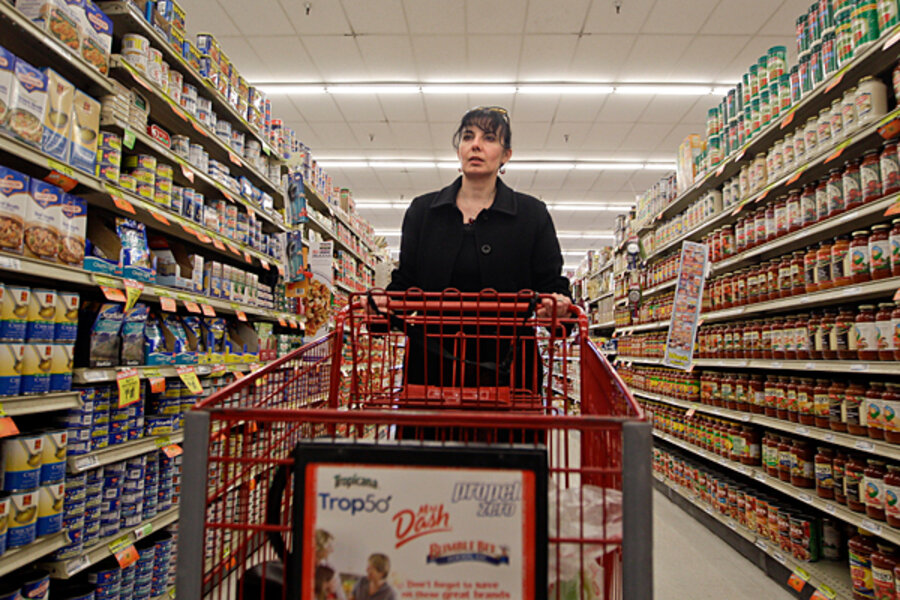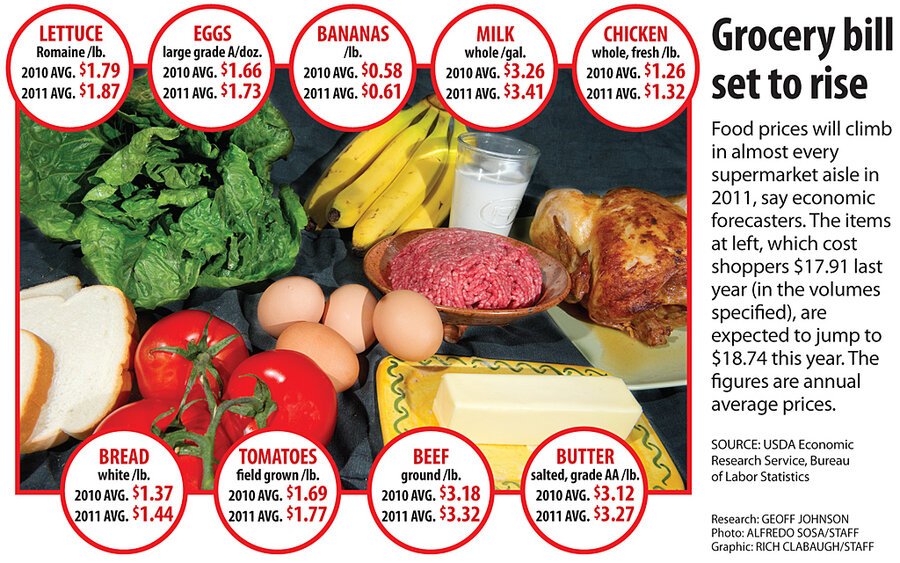Food costs soaring in US after harsh winter. Will higher prices last?
Loading...
| New York
After several years of almost no inflation, many Americans may be surprised to find some of their favorite foods, from burgers to pizza to a glass of orange juice, rising in price this year.
The producer price index, which measures changes in wholesale prices, rose 1.6 percent last month, mainly because of a jump in food prices, the Department of Labor Statistics reported on Wednesday. The food segment, up 3.9 percent, saw the biggest monthly increase since November 1974, with soaring vegetable prices responsible for about 70 percent of that jump. On Thursday, the government will report the consumer price index.
In the year ahead, expect to see the largest food price increases in the protein group: chicken, beef, and pork, as well as dairy items. One key reason: The price of corn, used as feed by ranchers and farmers, has doubled in the past year. But vegetarians won't get off easy: Produce and orange juice are rising sharply, as well.
Higher food prices have wide economic ramifications and are being watched closely by the Federal Reserve. From a business standpoint, food producers – from agricultural giants to the corner pizza parlor – must raise prices or watch their profit margins evaporate. Many middle-class households are financially stretched to the limit, so any extra expense for such basics as milk or bread makes their life even tougher. Organizations that help the poor with food, moreover, find they can't help as many people because their dollar doesn't go as far.
"The more you have to spend on a loaf of bread and a pound of ground beef, the less you have to spend on everything else," says Mark Zandi, chief economist at Moody's Analytics in West Chester, Pa. "It's like a tax increase, although it's not quite as bad as rising oil prices, since at least the revenues go to US farmers, truckers, and ag-equipment manufacturers."
The US Department of Agriculture expects the average price of food in 2011 to be 4 percent higher than last year. Some private forecasters say that, by December, prices could be as much as 6 percent higher than in December 2010.
"If food inflation comes in at 6 percent, it would be the most dramatic increase since 1982," says William Lapp, a consumer foods economist with his own firm, Advanced Economic Solutions in Omaha, Neb. "We had a 10-year period, from 1972 to 1981, when annual food prices rose sharply – including a two-year period when increases averaged 8.7 percent."
Three reasons food costs more
Mr. Lapp attributes the expected price increases to three main factors:
•The expanding middle class in rapidly developing countries such as Brazil, India, and China is boosting its consumption of protein, driving up demand.
•The US dollar has been weaker, helping American farmers to export their products but potentially leaving less for domestic consumption.
•Almost 40 percent of the US corn crop is now used to produce ethanol instead of food, although the farm lobby denies that diverting corn to ethanol production raises food prices.
Harsh winter weather is responsible for some of the food-price hikes. In December, cold weather in Florida wiped out the pepper, tomato, and green bean crops. A freeze in Mexico knocked out produce from there as well.
"It's kind of rare to have a one-two punch like that," says Lisa Lockridge, a spokeswoman for the Florida Fruit & Vegetable Association in Maitland, Fla. With two months of warmer weather in Florida, farmers will have produce back on the shelves by April, she says.
While that may help produce prices, critical grain crops may have more challenging weather ahead, says Paul Pastelok, senior meteorologist at Accu-Weather.com in State College, Pa. He expects the Midwest to be cooler than normal this spring, even into the summer. "This could stunt growth and the crop yield," he says.
Why Fed isn't warning of inflation
Normally, climbing prices might raise caution flags at the Federal Reserve. But in his March 1 testimony before Congress, Fed Chairman Ben Bernanke said he didn't view increases in commodity prices as a problem, in part because "inflation expectations" are "quite well anchored, which helps to keep inflation stable, even if there are temporary movements coming from commodity prices."
"The Fed's view is that there is very litle pass-through of higher costs," says Mr. Zandi. In addition, the Fed chairman is sanguine because bond investors have not indicated any fear of inflation or efforts to hedge against it in the financial markets, says Robert Brusca, an economist with Fact & Opinion Economics in New York.
Mr. Bernanke said he will continue to monitor inflation development, especially if inflation expectations were to rise.
He needs to go no further than Rick's Chop House in McKinney, Texas. In early March, restaurant owner Rick Wells was shocked to pay $25 a pound for sea bass. He immediately raised his menu price by $5 to maintain his profit margin.
In the past, his suppliers hesitated to charge more because of the sluggish economy, Mr. Wells says. "This year, my vendors are raising prices almost immediately."
For low-income Americans, a jump in food prices means food stamps don't buy as much. Groups who support food pantries feel the pressure as well. "It's scary for us; our dollars don't go as far," says Ross Fraser, a spokesman for Feeding America, a hunger-relief charity in Chicago.
Some distributors are still absorbing the price increases instead of passing them on to consumers. At the University of Virginia's large food-service network, UVA or its middlemen have absorbed the higher costs for coffee and produce, says Brent Beringer, director of food services. He hopes school will be out before the larger spike in food prices comes. "Then we will wait it out and see what happens in the fall, when [students'] meal-plan prices are set for the next year," he says.
Many food producers and restaurants are also softening the blow to their diners. Gluten-free pesto pizza, a bestseller for Simply Shari's, a national food producer based in Westlake Village, Calif., requires fresh basil – which has leapt from $3 to $6 a pound in the past month. "I cannot discontinue it," says Shari Cole. "No way I can raise my prices," she adds, noting her competitive industry. "We are really scrambling."
Some restaurateurs hope prices will start to fall once the weather improves. In Portland, Ore., Lincoln Restaurant's chef and owner Jenn Louis tries to buy as much as she can from local farmers. Bad weather kept local cows from grazing enough, sending her outlays for butter from $60 a case to $100 a case.
She hopes to adapt her recipes to lessen the financial impact. "With the price of butter up, you can absorb that if you know how to use everything else on your shelves," she says.
As rising costs mount, such adaptations will surrender to the inevitable price increases for consumers, Lapp argues. The food industry's grain expenses have increased by $40 billion since July, but it has absorbed most of those costs – so far.
"Either people in the middle will have to continue to absorb those increases or the costs will have to be passed on to the consumer," he says.






